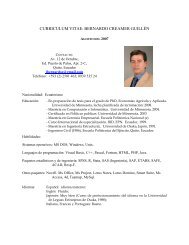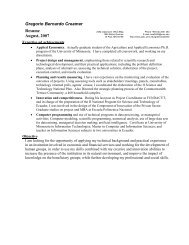Water-Quality Trading: Can We Get the Price of Pollution Right?
Water-Quality Trading: Can We Get the Price of Pollution Right?
Water-Quality Trading: Can We Get the Price of Pollution Right?
You also want an ePaper? Increase the reach of your titles
YUMPU automatically turns print PDFs into web optimized ePapers that Google loves.
equilibrium must satisfy <strong>the</strong> market-clearing condition (21), we have∑d effii¯L i = ∑ i d effiDT RSei . (26)However, because <strong>the</strong> aggregate damage function is nonlinear, we have∑d effii e effi ≠ D(e eff ). (27)Combining (25), (26), and (27), we see that∑d effii¯L i = ∑ d effii e dtrsiwhich contradicts that e dtrs = e eff . This completes <strong>the</strong> pro<strong>of</strong>.= D(e eff ) ≠ ∑ d effii e effi .As is evident from <strong>the</strong> pro<strong>of</strong>, <strong>the</strong> DTRS breaks down because <strong>the</strong> initial allocation <strong>of</strong> permits ¯Lfollows Farrow et al.’s original allocation rule (25). A natural question arises: what would happenif one were to use a different allocation rule? For example, <strong>the</strong> regulator could allocate permitsso that S(¯L 1 , . . . , ¯L n ) = TD. Here one encounters an insuperable difficulty: <strong>the</strong>re is no allocationrule <strong>the</strong> regulator could rely upon in this case. Indeed, <strong>the</strong> problem arises under <strong>the</strong> TRS too.To see this, suppose that <strong>the</strong> regulator agreed upon <strong>the</strong> desired level <strong>of</strong> aggregate damage TD.Because <strong>the</strong> damage function is nonlinear, <strong>the</strong>re will inevitably exist many vectors ¯L such thatS(¯L 1 , . . . , ¯L n ) = TD. The regulator’s problem is indeterminate. (Recall that D is <strong>the</strong> compositionfunction D(e) = S(T e).)In <strong>the</strong> following section, we investigate how <strong>the</strong> TRS and DTRS perform, relative to <strong>the</strong> efficientsolution as well as to each o<strong>the</strong>r, if <strong>the</strong> initial allocation <strong>of</strong> permits follows such an arbitrary rule.5 A numerical modelThe results <strong>of</strong> <strong>the</strong> previous two sections imply that in numerous watersheds <strong>of</strong> practical interest,water-quality trading based on ei<strong>the</strong>r TRS or DTRS may not achieve <strong>the</strong> efficient outcomes. Thenumerical exercise reported here is designed to quantify <strong>the</strong> welfare losses associated with <strong>the</strong>shortcomings <strong>of</strong> <strong>the</strong> two systems, relative to each o<strong>the</strong>r and also relative to <strong>the</strong> social optimum.<strong>We</strong> do this by constructing a numerical model. Though <strong>the</strong> model is fairly sophisticated in itsconstituent parts, incorporating <strong>the</strong> relevant scientific aspects <strong>of</strong> a realistic watershed, in order toilluminate our key question we have kept it relatively small. The specific parameter values arehypo<strong>the</strong>tical but realistic.Consider a second-best scenario in which <strong>the</strong> regulator has imperfect information regarding polluters’abatement costs, but has perfect information regarding environmental damages. Toge<strong>the</strong>r,<strong>the</strong>se conditions mean that <strong>the</strong> fundamental constraints ¯X (for <strong>the</strong> TRS) or TD (for <strong>the</strong> DTRS)cannot be set at <strong>the</strong> efficient levels. There can be infinitely many ways to allocate initial permitsunder such a scenario, all meeting <strong>the</strong> constraint in <strong>the</strong> absence <strong>of</strong> trade. <strong>We</strong> assume that <strong>the</strong> totalnumber <strong>of</strong> permits in <strong>the</strong> initial allocation is equal to <strong>the</strong> socially optimal level. This assumptionenables us to disentangle <strong>the</strong> sources <strong>of</strong> inefficiency, as it implies that TRS and DTRS could potentiallyachieve <strong>the</strong> social optimum. Put ano<strong>the</strong>r way, if ei<strong>the</strong>r <strong>the</strong> TRS or <strong>the</strong> DTRS fails to achieve<strong>the</strong> social optimum, it is not because <strong>the</strong> supply <strong>of</strong> permits is incorrect relative to <strong>the</strong> optimum.Indeed, <strong>the</strong> <strong>the</strong>oretical premise <strong>of</strong> ideal permit trading is that, in <strong>the</strong> absence <strong>of</strong> market failures oro<strong>the</strong>r distortions, <strong>the</strong> trading outcome does not depend on <strong>the</strong> initial distribution <strong>of</strong> permits. Herewe have no market imperfections, but <strong>the</strong> premise is violated anyway.13



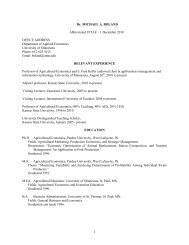
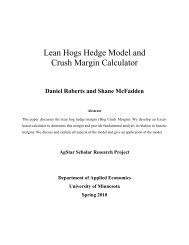

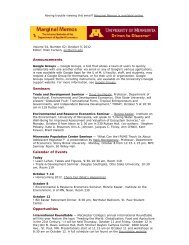


![Publications Since 2000[1].docx](https://img.yumpu.com/30237513/1/190x245/publications-since-20001docx.jpg?quality=85)

